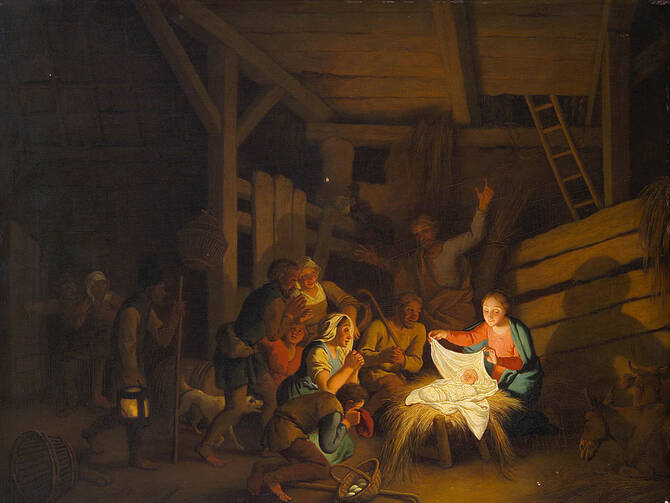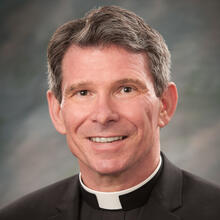A Homily for the Nativity of the Lord
Despite its small size, our 25-bed rural hospital often cares for out-of-town patients. Not long ago, one of them asked to see me. The room was in shadows when I knocked on the door, but a voice from inside responded, “Please come in, Father.”
That’s how I met Ruth, a charming, slightly eccentric older woman. Charming because, as she said, she was a storyteller. Kids: “Scattered to both coasts.” Husband: “Father, don’t ask. He was a disaster.” Eccentric because she was wearing a turban and sunglasses. I knew better than to ask why. I moved ahead, a little excited to be ministering to Norma Desmond.
Among the stories that Ruth told me was that of her conversion, followed by that of her whole family, to Catholicism. She had grown up in southeast Kansas, where Catholic communities are sparse. One day, Ruth and her sister were in the local public school. Why they were there on a Sunday, I do not know, but Ruth says that they heard the most unearthly, beautiful singing and followed it to the door of the auditorium. She and her sister had pressed their noses to a window in the door when a janitor opened it from the inside. They tumbled in and were invited to stay for the Mass being celebrated.
Ruth still remembers the date, May 30th, 1948. “Father, the music, the scene! It was the most beautiful thing I had ever experienced. That very day my sister and I decided to become Catholic. Our entire family followed us.”
The passion accounts are dramas. The infancy stories are tableaus. They simply want us to see something.
Someone must have had a stunning vestment, or the choir really was extraordinary. How exquisite could a Mass, even a Tridentine one, be in a high school auditorium? Yet that beautiful tableau revealed the truth of Christ’s presence to Ruth and her sister. In sharing the story of Christ’s birth, the evangelists hope to accomplish the same.
Did you know that the Gospels were composed backward? The accounts of Christ’s death were probably the first to be written. Hard to proclaim the resurrection without the passion. Eventually, believers wanted to know how the story began.
Only two of the four Gospels relate Christ’s birth. They intend to prefigure the passion, set its stage, but they are quite distinctive in style from those narratives. The passion accounts are dramas. The infancy stories are tableaus. They simply want us to see something.
Come Holy Week, we can read the passion narratives as plays. There are distinct speaking roles and horrible turns of fortune. At Christmas time, we encourage the kids to present the nativity, because it is more scene than stage craft. The principal characters, Mary and Joseph, do not even speak. Only the angels “who sang creation’s story/ now proclaim Messiah’s birth!”
A sign of their veracity is that neither Luke nor Matthew invent dialogue for their nativity scenes. No need. Sight speaks for itself.
All four of our Gospels eschew what might be called “the human-interest factor.” They are proclamations without narrative background. No filler. If someone speaks, it is always to proclaim the truth of Jesus Christ. A sign of their veracity is that neither Luke nor Matthew invent dialogue for their nativity scenes. No need. Sight speaks for itself.
We try to explain the passion narratives to a child, to relate what is happening and why. Yet we carry toddlers over to see the crib of Jesus. Vision alone carries the revelatory load. Words are not so necessary because the Word made flesh lies shivering in the straw.
How aptly entitled is our most beloved Christmas hymn.
Silent night, holy night!
All is calm, all is bright.
Round yon Virgin, Mother and Child.
Holy infant so tender and mild,
Sleep in heavenly peace,
Sleep in heavenly peace
Both evangelists are content to assemble a scene, a vibrant tableau. St. Francis of Assisi captured the revelatory essence of Christmas when he recreated a living tableau with people and livestock in 1224 in the Italian village of Greccio. In the words of the hymn, the sight alone will make us quake.
Silent night, holy night!
Shepherds quake at the sight.
Glories stream from heaven afar
Heavenly hosts sing Alleluia,
Christ the Savior is born!
Christ the Savior is born
The infancy narratives are not drama. They are tableaus. Like that 1940s Mass in southeastern Kansas, they accomplish their purpose in setting a scene. They are convinced that sight alone will have the effect of a vision. It will be revelatory. It will reveal, to hearts that are ready to receive, who Christ is. In Bethlehem, a swaddled babe. In the Mass, his sacramental presence cloaked by bread and wine.
Silent night, holy night!
Son of God love's pure light.
Radiant beams from Thy holy face
With the dawn of redeeming grace,
Jesus Lord, at Thy birth
Jesus Lord, at Thy birth
Whether the creche is in our homes, our churches or on our roadsides, the infancy narratives are really two enchanted scenes. In Luke, a child in a manger, surrounded by his parents, shepherds and livestock. In Matthew, there is a bit of a plot, but all resolves into a revelatory tableau as three magi lay their treasures before the newborn King.
Dramatically proclaimed or physically envisioned, the Gospel only becomes itself when God’s grace enters the heart. Two other little girls might have tumbled into that auditorium and seen nothing special. But Ruth and her sister, to borrow a phrase from the resurrection accounts, “saw and believed.”
Without grace, Christmas is a fantasy, better suited to kids than adults. With grace, it becomes the most subtle, yet most substantial of promises given to the human heart. A single verse spreads out the saving scene. A silent night reveals by showing.
And this will be a sign for you:
you will find an infant wrapped in swaddling clothes
and lying in a manger (Lk 2:12).








